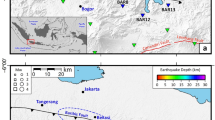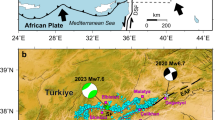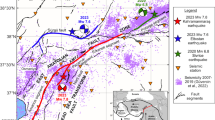Abstract
The seismic gap theory1 identifies regions of elevated hazard based on a lack of recent seismicity in comparison with other portions of a fault. It has successfully explained past earthquakes (see, for example, ref. 2) and is useful for qualitatively describing where large earthquakes might occur. A large earthquake had been expected in the subduction zone adjacent to northern Chile3,4,5,6, which had not ruptured in a megathrust earthquake since a M ∼8.8 event in 1877. On 1 April 2014 a M 8.2 earthquake occurred within this seismic gap. Here we present an assessment of the seismotectonics of the March–April 2014 Iquique sequence, including analyses of earthquake relocations, moment tensors, finite fault models, moment deficit calculations and cumulative Coulomb stress transfer. This ensemble of information allows us to place the sequence within the context of regional seismicity and to identify areas of remaining and/or elevated hazard. Our results constrain the size and spatial extent of rupture, and indicate that this was not the earthquake that had been anticipated. Significant sections of the northern Chile subduction zone have not ruptured in almost 150 years, so it is likely that future megathrust earthquakes will occur to the south and potentially to the north of the 2014 Iquique sequence.
This is a preview of subscription content, access via your institution
Access options
Subscribe to this journal
Receive 51 print issues and online access
$199.00 per year
only $3.90 per issue
Buy this article
- Purchase on Springer Link
- Instant access to full article PDF
Prices may be subject to local taxes which are calculated during checkout




Similar content being viewed by others
References
McCann, W. R., Nishenko, S. P., Sykes, L. R. & Krause, J. Seismic gaps and plate tectonics: seismic potential for major boundaries. Pure Appl. Geophys. 117, 1082–1147 (1979)
Hayes, G. P. et al. Seismotectonic framework of the February 27, 2010 Mw 8.8 Maule, Chile earthquake sequence. Geophys. J. Int. 105, 1034–1051 (2013)
Comte, D. & Pardo, M. Reappraisal of great historical earthquakes in the northern Chile and southern Peru seismic gaps. Nat. Hazards 4, 23–44 (1991)
Loveless, J. P. & Meade, B. J. Spatial correlation of interseismic coupling and coseismic rupture extent of the 2011 Mw = 9:0 Tohoku-oki earthquake. Geophys. Res. Lett. 38, L17306 (2011)
Chlieh, M. et al. Interseismic coupling and seismic potential along the Central Andes subduction zone. J. Geophys. Res. 116, B12405 (2011)
Béjar-Pizarro, M. et al. Andean structural control on interseismic coupling in the North Chile subduction zone. Nature Geosci. 6, 462–467 (2013)
Podlaha, A. & Bowen, S. Impact Forecasting: April 2014 Global Catastrophe Recap, AON Benfield Report <http://thoughtleadership.aonbenfield.com/Documents/20140507_if_april_global_recap.pdf> (April 2014)
Centro Sismológico Nacional, Universidad de Chile <http://www.sismologia.cl/>
Kausel, E. Los terremotos de Agosto de 1868 y Mayo de 1877 que afectaron el Sur del Peru y Norte de Chile. Boll. Acad. Chil. Ciencias 3, 8–12 (1986)
Witze, A. Chile quake defies expectations. Nature 508, 440–441 (2014)
Béjar-Pizarro, M. et al. Asperities and barriers on the seismogenic zone in the North Chile: state-of-the-art after the 2007 Mw 7.7 Tocopilla earthquake inferred by GPS and InSAR data. Geophys. J. Int. 183, 390–406 (2010)
Armijo, R. & Thiele, R. Active faulting in Northern Chile: ramp stacking and lateral decoupling along a subduction plate boundary? Earth Planet. Sci. Lett. 98, 40–61 (1990)
Hayes, G. P., Wald, D. J. & Johnson, R. L. Slab1.0: a three-dimensional model of global subduction zone geometries. J. Geophys. Res. 117, B01302 (2012)
Ji, C., Wald, D. J. & Helmberger, D. V. Source description of the 1999 Hector Mine, California, earthquake, part I: wavelet domain inversion theory and resolution analysis. Bull. Seismol. Soc. Am. 92, 1192–1207 (2002)
Blaser, L., Krüger, F., Ohrnberger, M. & Scherbaum, F. Scaling relations of earthquake source parameter estimates with special focus on subduction environment. Bull. Seismol. Soc. Am. 100, 2914–2926 (2010)
Lay, T., Yue, H., Brodsky, E. E. & An, C. The 1 April, 2014 Iquique, Chile Mw 8.1 earthquake rupture sequence. Geophys. Res. Lett. 41, 3818–3825 (2014)
Jordan, T. H. & Sverdrup, K. A. Teleseismic location techniques and their application to earthquake clusters in the south-central Pacific. Bull. Seismol. Soc. Am. 71, 1105–1130 (1981)
Walker, R. T., Bergman, E., Jackson, J., Ghorashi, M. & Talebian, M. The 2002 June 22 Changureh (Avaj) earthquake in Qazvin province, northwest Iran: epicentral relocation, source parameters, surface deformation and geomorphology. Geophys. J. Int. 160, 707–720 (2005)
Herrmann, R. B., Benz, H. & Ammon, C. J. Monitoring the earthquake source process in North America. Bull. Seismol. Soc. Am. 101, 2609–2625 (2011)
Ekström, G., Nettles, M. & Dziewónski, A. M. The global CMT project 2004–2010: centroid-moment tensors for 13,017 earthquakes. Phys. Earth Planet. Inter. 200–201, 1–9 (2012)
Lay, T. et al. The 2006–2007 Kuril Islands great earthquake sequence. J. Geophys. Res. 114, B11308 (2009)
Hayes, G. P., Furlong, K. P., Benz, H. M. & Herman, M. W. Triggered aseismic slip adjacent to the 6 February 2013 Mw 8.0 Santa Cruz Islands megathrust earthquake. Earth Planet. Sci. Lett. 388, 265–272 (2014)
Hayes, G. P. et al. 88 hours: the U.S. Geological Survey National Earthquake Information Center response to the 11 March 2011 Mw 9.0 Tohoku earthquake. Seismol. Res. Lett. 82, 481–493 (2011)
Jordan, T. H. & Jones, L. M. Operational earthquake forecasting: some thoughts on why and how. Seismol. Res. Lett. 81, 571–574 (2010)
Metois, M. et al. Revisiting the North Chile seismic gap segmentation using GPS-derived interseismic coupling. Geophys. J. Int. 194, 1283–1294 (2013)
Bedford, J. et al. A high-resolution, time-variable afterslip model for the 2010 Maule Mw = 8.8, Chile megathrust earthquake. Earth Planet. Sci. Lett. 383, 26–36 (2013)
Integrated Plate Boundary Observatory Chile. <http://www.ipoc-network.org/>
Stein, R. S., Barka, A. A. & Dieterich, J. H. Progressive failure on the North Anatolian fault since 1939 by earthquake stress triggering. Geophys. J. Int. 128, 594–604 (1997)
Brodsky, E. E. & Lay, T. Recognizing foreshocks from the April 2014 Chile earthquake. Science 344, 700–702 (2014)
GEBCO. General Bathymetric Chart of the Oceans <http://www.gebco.net>
Wessel, P. & Smith, W. H. F. Free software helps map and display data. EOS 72, 445–446 (1991)
USGS. About ANSS Comprehensive Catalog <http://earthquake.usgs.gov/earthquakes/map/doc_aboutdata.php>
DeMets, C., Gordon, R. G. & Argus, D. F. Geologically current plate motions. Geophys. J. Int. 181, 1–80 (2010)
USGS. M8.2—94km NW of Iquique, Chile (BETA), 2014-04-01 23:46:47 UTC <http://earthquake.usgs.gov/earthquakes/eventpage/usc000nzvd#scientific_finite-fault>
Duputel, Z., Rivera, L., Kanamori, H. & Hayes, G. W phase source inversion for moderate to large earthquakes (1990–2010). Geophys. J. Int. 189, 1125–1147 (2012)
Nevada Geodetic Laboratory. <http://geodesy.unr.edu/>
Barnhart, W. D., Hayes, G. P., Samsonov, S. V., Fielding, E. J. & Seidman, L. E. Breaking the oceanic lithosphere of a subducting slab: the 2013 Khash, Iran earthquake. Geophys. Res. Lett. 41, 32–36 (2014)
Sambridge, M. Geophysical inversion with a neighbourhood algorithm—I. Searching a parameter space. Geophys. J. Int. 138, 479–494 (1999)
Barnhart, W. D. & Lohman, R. B. Automated fault model discretization for inversions for coseismic slip distributions. J. Geophys. Res. Solid Earth 115, B10419 (2010)
Okada, Y. Internal deformation due to shear and tensile faults in a half-space. Bull. Seismol. Soc. Am. 82, 1018–1040 (1992)
Acknowledgements
We thank R. Briggs for his comments in improving the manuscript. We thank the CSN, and member institutions of the IPOC network for their operation of seismic stations in northern Chile and for the contribution of waveform data and phase picks to this study. This study made use of broadband seismic data from globally distributed seismometers available to the USGS NEIC in real time or near real time (networks AE, BK, C, CN, CU, DK, G, GE, GT, IC, II, IU, IW and US) and archived in the NEIC Central Waveform Buffer and at the Incorporated Research Institutions for Seismology Data Management Center. RADARSAT-2 data were provided by the Canadian Space Agency and MDA Corporation. Bathymetry data come from GEBCO 2008 (ref. 30). Many of the figures were made with the Generic Mapping Tools software package31. National Science Foundation grant EAR-1153317 provided support to K.P.F. and M.W.H. for this research. Any use of trade, product, or firm names is for descriptive purposes only and does not imply endorsement by the US Government.
Author information
Authors and Affiliations
Contributions
G.P.H., K.P.F. and W.D.B. wrote the manuscript. G.P.H. generated Figs 1, 2 and 4; M.W.H. generated Fig. 3. G.P.H., M.W.H. and W.D.B. generated Extended Data figures. G.P.H. conducted seismic fault inversions and moment deficit calculations. M.W.H. conducted stress transfer calculations. W.D.B. conducted geodetic fault inversions. G.P.H. and W.D.B. were jointly responsible for fault models. S.R. and S.B. contributed regional real-time analyses and data used in seismic inversions and earthquake relocations. E.B. and H.M.B. conducted earthquake relocations. P.S.E. contributed to the real-time analysis of the earthquake sequence and edited the manuscript. S.S. scheduled the acquisition of RADARSAT-2 data and performed InSAR analysis.
Corresponding author
Ethics declarations
Competing interests
The authors declare no competing financial interests.
Extended data figures and tables
Extended Data Figure 1 Depth resolution of W-phase inversion.
Relative misfit of W-phase inversions using fixed depths from 13.5 to 40.5 km. All solutions from 13.5 to 30.5 km are within 1% of the best solution at 25.5 km depth. Solutions to 40.5 km are within 3% of the best-fit solution.
Extended Data Figure 2 The effect of fault geometry on teleseismic source inversions.
Top: comparison of source inversions on a single-plane model with multi-plane models that gradually improve on their match to slab geometry, with models for one plane (left), three planes (middle) and five planes (right). As the fit to slab geometry improves (shown in the bottom panel), slip gradually migrates up-dip and west of the coastline. Bottom: cross-section of the subduction zone through the hypocentre, perpendicular to the strike of the source inversions. Slab geometry is shown with a red dashed line, and historical moment tensors with grey focal mechanisms. Green dots represent a projection of the single-plane model onto the cross-section, blue represent the three-plane model, and red the five-plane model.
Extended Data Figure 3 Geodetic fault modelling of the Iquique mainshock and largest aftershock.
Models are inverted from a single descending RADARSAT-2 interferogram (1 July 2011 to 4 April 2014; incidence angle 32°, azimuth −166°) consisting of five concatenated Multi-Look Fine frames, and displacements are determined from GPS station IQQE. a–f, For models inverted onto a single fault plane (a–c) and onto the Slab1.0 model geometry (d–f), slip distributions show the ‘best-fitting’ solution (a, d), as determined by the jRi criterion, as well as relatively rough (b, e) and smooth (c, f) models to demonstrate the dependence of up-dip slip on regularization. Dots indicate the relocated epicentres of the M 8.2 and M 7.7 events, respectively. g, Unwrapped interferogram (negative is motion away from the satellite, or subsidence). h, Down-sampled interferogram with GPS vectors from the M 8.2 (blue) and M 7.7 (black) events at station IQQE. i–k, Predicted surface displacements from the best-fitting geodetic (i, j) and teleseismic (k) finite fault models (synthetic interferogram plus synthetic GPS vector in red). The predicted displacements from teleseismic data include the displacements of both the M 8.2 and M 7.7 models.
Extended Data Figure 4 Characteristics of the 2010 Maule and 2014 Iquique earthquake sequences.
a, Plot of earthquake latitude against time through the duration of the Iquique sequence. Foreshocks to the 1 April M 8.2 earthquake are plotted in red, aftershocks between 1 April and the M 7.7 event on 3 April in orange, and subsequent aftershocks in yellow. This temporal history of the sequence reveals northward (foreshock) followed by southward (early aftershocks) spatial migration across the subduction zone interface. b, Gutenberg–Richter relationship for this period of the 2014 Iquique sequence, including 600 earthquakes. Magnitude of completeness is about M 3.8, and the b value is 0.73. c, Triangle diagram for the sequence, used to display the distribution of best double-couple mechanisms of CMT solutions. These plots show the relative dominance of strike-slip (SS, top), normal (No, bottom left) and thrust (Th, bottom right) faulting for an earthquake mechanism. The regions between each vertex and the nearest red contour denote dominant faulting style. Symbols are coloured as in a. d, Plot of earthquake latitude against time through the duration of the Maule 2010 sequence. As in a, red circles represent foreshocks, orange the first 27 h of aftershocks, and yellow subsequent events. e, Gutenberg–Richter relationship for the 2010 Maule sequence, including 2,450 earthquakes. Magnitude of completeness is about M 3.7, and the b value is 0.83. f, Triangle diagram for Maule; symbols as in c.
Rights and permissions
About this article
Cite this article
Hayes, G., Herman, M., Barnhart, W. et al. Continuing megathrust earthquake potential in Chile after the 2014 Iquique earthquake. Nature 512, 295–298 (2014). https://doi.org/10.1038/nature13677
Received:
Accepted:
Published:
Issue Date:
DOI: https://doi.org/10.1038/nature13677
This article is cited by
-
Space-time clustering of seismic events in Chile using ST-DBSCAN-EV algorithm
Environmental and Ecological Statistics (2024)
-
Feedback between megathrust earthquake cycle and plate convergence
Scientific Reports (2023)
-
Multidisciplinary analyses of the rupture characteristic of the June 14, 2020, Mw 5.9 Kaynarpınar (Karlıova, Bingöl) earthquake reveal N70E-striking active faults along the Yedisu Seismic Gap of the North Anatolian Fault Zone
International Journal of Earth Sciences (2023)
-
Megathrust reflectivity reveals the updip limit of the 2014 Iquique earthquake rupture
Nature Communications (2022)
-
Tsunami Modeling in the South American Subduction Zone Inferred from Seismic Coupling and Historical Seismicity
Pure and Applied Geophysics (2021)
Comments
By submitting a comment you agree to abide by our Terms and Community Guidelines. If you find something abusive or that does not comply with our terms or guidelines please flag it as inappropriate.



